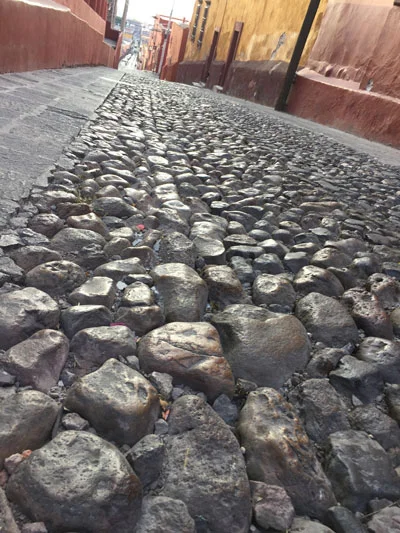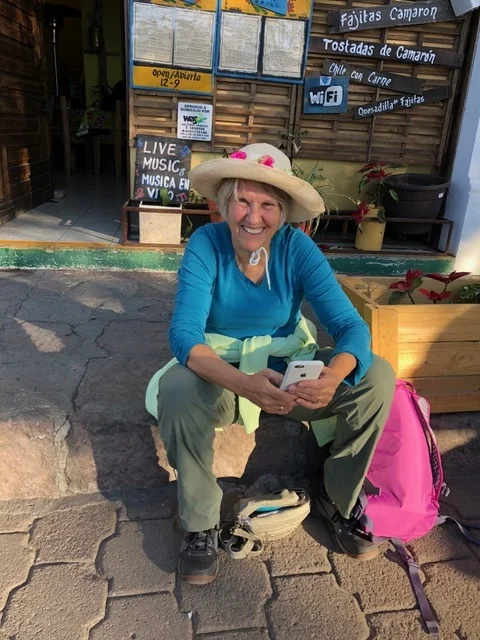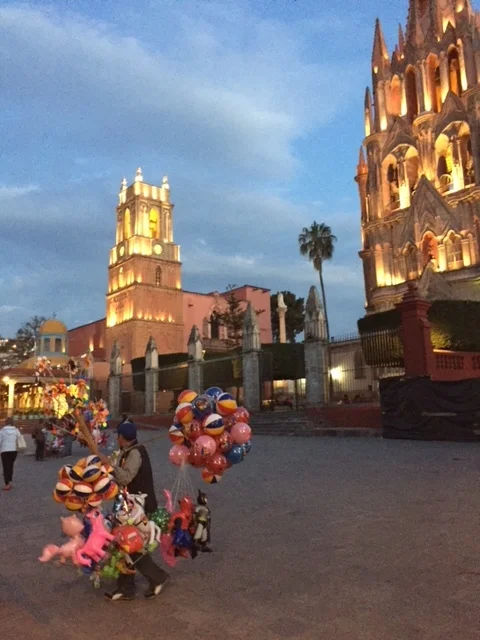Six Weeks in San Miguel de Allende
/It’s been forty-five years since I spent a year and a half in Mexico and South America backpacking with Dave. I am back again under relatively posh circumstances. Joe and I have a condo overlooking the valley, a washer and dryer, a kitchen, two bedrooms, and hot water. This is quite different from the days spent in a grass hut on the edge of the sea when we fished for our dinner and slept in hammocks. Read my book about that journey, South of Ordinary here. Distant memories come alive as I walk through the open markets with their sweet smell of cut gladiolas and roses, papayas and mangos, and the gentle, kind, people who live here in San Miguel, Mexico. I remember to steer clear of the market's meat section. The smell kills any appetite that might be rumbling in my belly. There is something on the counter that looks like compressed intestines in a large block that appears to be sold by the slice or chunk. The fruits and vegetables are so very fresh and the carrots sweet as a birds song. The tiny bananas are loaded with that rich yellow banana taste and a twang of tart. It’s easy to skip the meat here.
Last week, we took a traditional Mexican cooking class. I learned how to prepare nopales— flat cactus leaves, a cousin to aloe vera with similar healing qualities. Our teacher Chris, said the nopale guts are good for your skin—rub it on and find youth. Eating it will alleviate digestive problems. I am up for trying that because I don't go anywhere without the Zantac and Tums. Is it the coffee or the chilis that cause this fire in my belly?
Yesterday, I bought four grass-green nopale leaves to make a stew. I noticed some brown clumps, golf-ball-size, circling a plate. Do I want some of this too? "Que es esto?" She answers in bullet fast spanish. When I look confused she slices off a pea-sized chunk and offers it to me on the knife blade— “Probarlo.” I shy away. "Probarlo," and she moves the knife closer. I don't think I can get out of this. I am reluctant because I have no clue what this is— fowl or vegetable or dirt. I expect it to be some sort of ground sesame sweet thing like halvah. I take half of what she offers. It sits on my tongue and then sticks like peanut butter to the roof of my mouth. It is a little gritty, then I feel the fire. “Ay carrumba, pica mucho.” and I dance around waving my hand in front of my mouth. Apparently, the grandma sitting on the chair finds this quite hilarious and rolls and shakes on her chair. "ay ay ay." I add to her amusement. In retrospect, it might have been pulverized dried chiles mixed with something to make it stick together. Perhaps, flavoring for my nopale stew.
Oh how I wish I was fluent in Spanish. I can get along but I understand less than half of what is said. In context, I can get it most of the time. We are—so—in another country. It’s wonderful and exotic and scary. I think the scariest thing is thinking about getting sick or getting a bad toothache and not knowing who to go to. We did ask our gringo neighbor what he does for health care and he had comforting words." It's great, I had all my operations down here including a triple by-pass at a third of the US cost.." Alrighty then.
While I walk down the cobblestone streets on my way to the open air market, I watch out for protruding loops of electrical wire, or overhanging window ledges right at eye level or a spurt of water from a roof top pipe falling on your shoulders or head, into the street—I haven't yet figured out what this is. Joe says, they flushed their toilet, but I am pretty sure it is just grey water. It's muy peligroso to look at your phone and walk at the same time, your foot might land in a hole or the occasional soft dog shit. Bright adobe colors of sandy red and aquamarine blue change at every casa, all hooked together like the houses in San Francisco or Europe.
Cobble is a good word for the stones because its kind of like river rock, not flat and smooth where they fit together but rounded high with large spaces between. As cars pass, they rattle and whine and plunk and pop. I grab Joe’s arm to cross the street. I don’t want to turn an ankle. I am glad I brought my light-weight Charros hiking shoes and cushioned socks from REI. Happily, the streets are lined with flat stones for walking.
Cars are almost always coming, you don’t wait for them to pass, you just step off the curb and advance and they stop. Unless, of course they are driven by chilangos—that’s the word for tourists from the big city. I remember in Fraser Colorado ski country we used to call them "turkeys". The tourists sometimes don’t know the San Miguel courtesies. But mostly the cars and busses are very aware and considerate of pedestrians. They drive relatively slowly so they don't bounce right off the road. We walk everywhere with our nylon REI bright pink or blue packs. In this we have water, pesos, and our jacket, because the temperature can vary 20 degrees depending if the sun is out. We also use the pack to stash purchases from the store, like onions, papayas, tomatoes, san peligrino—if we can get it. That fizzy water just tastes so good here, but it’s a big price to pay carrying the bottles up the hill.
It is deceiving. What looks like a plain wooden door can open to a palace — a patio lined with leafy pink and red blossoms before you get to the closed in living quarters. It is common for part of the house to be open to the sky, like a sitting or dining area. You can't tell if a castle or a shanty is behind the walled doors. I become hot and weary when I think of the work it must have taken to lay each stone on these cobblestone streets. Some of the stones are slick and shiny from wear. The good thing is they last forever. Not like the failing asphalt and concrete which needs constant repair in Minnesota from the salt and ice that eats away at the streets every winter.
Nectar Restaurante with hummingbird guests
Ready for dinner at don luca's grill and waiting for spanish class friends to arrive. We took an intensive, Warren hardy's, storytelling course. Which I highly recommend.
Jardine at San miguel de allende. We live ten blocks up the hill.
Its easy to make friends in San Miguel de Allende because gringos are everywhere and we are all fish out of water, however many of the gringos have found their home here and are permanent residents, having given up the fast paced life in in the US. Someone told me taxes are $300 a year and houses build for $80 a square foot vs $5 or $600 in parts of California. I love that you can do fine here without a car and can walk everywhere. There is a lot of english spoken here. When we first arrived last year, we didn’t know how to change money. So we asked a gringo in the restaurant El Correo. She told us where the atm machine was off the Jardine and miraculously, you put your card in its mouth and out spits pesos. Some say your credit card is more easily compromised here, so we are trying to use only pesos. Our card's daily limit is 5000 pesos, that’s about $250 US.
We paid 1150 a month for our condo. Two of the best features are a screened in roof and walls for the laundry room and a roof top deck overlooking the city. The laundry has a couple ropes which come in handy to dry the dish rags and hand towels. I love having the door open while I cook and feeling the breeze whistle by my face and arms and blow the cooking smells out the windows.
Flowers thrive in San Miguel. Azaleas, geraniums, and tulips. Purple and pink bouganvilla hug the adobe walls with bunches of blossoms. San Miguel had an unusual freeze in January and the pots on my balcony have three dead and pitiful looking wandering jews with their crusty brown leaves. But now it is March and most of the plants have recovered or been replaced.
I feel more creative here. I feel like I have the time. I have been painting watercolor flowers and mountain scenes with impressionistic loose water colors. I am practicing the mixing of colors and discovering the right blend of water and paint to dab on a flower or the sky or a vase.
I also bought a ukelele and am learning "The Lion Sleeps Tonight." Its a good beginner's song. I imagine myself tapping and chucking on my ukelele as we putt around Bond Lake this summer, singing about a sleepy jungle lion.






